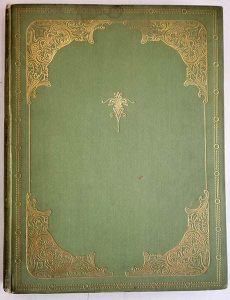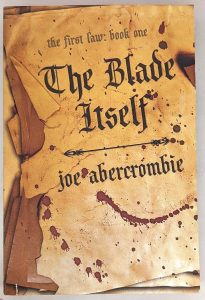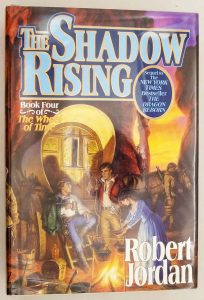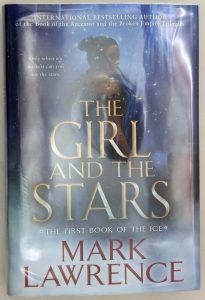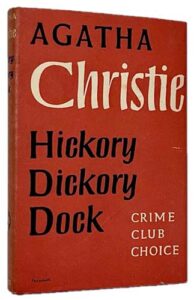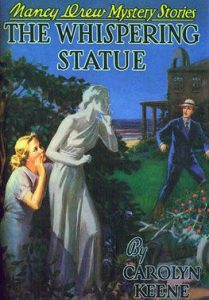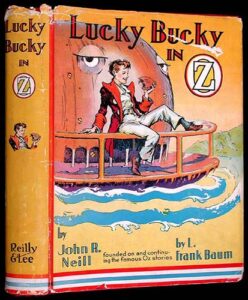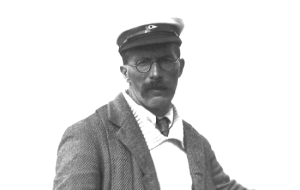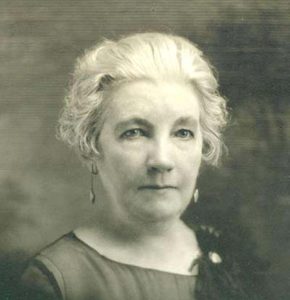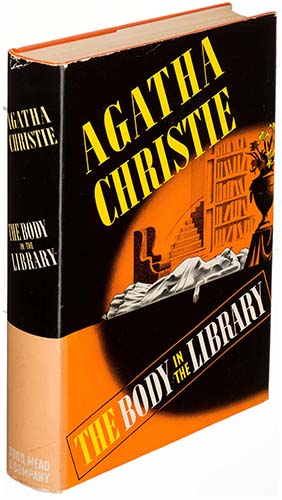
The Body in the Library is a work of detective fiction by Agatha Christie and first published in the US by Dodd, Mead and Company in February 1942 and in UK by the Collins Crime Club in May of the same year. The US edition retailed at $2.00 and the UK edition at seven shillings and sixpence. The novel features her fictional amateur detective, Miss Marple.
In her Author’s Foreword, Christie describes “the body in the library” as a cliché of detective fiction. She states that when writing her own variation on this theme, she decided that the library should be a completely conventional one while the body would be a highly improbable and sensational one.
In Christie’s Cards on the Table, published six years earlier, Anne Meredith knows Ariadne Oliver as the writer of a book called The Body in the Library.
Plot Summary
[SPOILER ALERT]
The maid at Gossington Hall wakes Mrs Bantry by saying, “There is a body in the library!” Dolly Bantry then wakes her husband, Colonel Arthur Bantry to go downstairs. He finds the dead body of a young woman on the hearth rug in the library, with heavy makeup, platinum-blonde hair, and a silver-spangled dress. The colonel calls the police, and Mrs Bantry calls her old friend, Miss Marple. The police investigators include Colonel Melchett and Inspector Slack.
Trying to identify this dead young woman, Melchett heads to the nearby cottage of Basil Blake, but Blake’s girlfriend Dinah Lee, a platinum blonde, is very much alive and arrives at the house while Melchett is interviewing Blake. Dr Haydock’s autopsy reveals that the young woman, healthy but not fully mature, died between 10 pm and 12 midnight the previous evening, had been drugged and then strangled, and was not sexually molested. Miss Marple notices that the appearance of this girl is not right, from her bitten fingernails to her old dress. She shares these observations with Dolly.
Hotel guest Conway Jefferson reports Ruby Keene, an 18-year-old dancer at the Majestic Hotel in Danemouth, as missing. Josie Turner, employee at the hotel, identifies the body as that of her cousin Ruby. Guests saw Ruby as late as 11 pm dancing with George Bartlett, but Ruby did not appear for her dance demonstration at midnight. Conway tells police he has revised his will to favour Ruby, until the legal adoption is completed.
Dolly and Miss Marple move to the Majestic to investigate further. Conway calls Sir Henry Clithering to join the investigation; Sir Henry sees Miss Marple at the hotel and in turn invites her to investigate.
Conway made large financial settlements for his children at the time each married. Then his wife, son and daughter were killed in an aeroplane crash eight years earlier. The three grieving survivors, son-in-law Mark, daughter-in-law Adelaide, and Conway, made up a household. They were playing bridge that evening with Josie. Police initially rule out the son-in-law and daughter-in-law, thinking each one is financially secure. But both are short of money, as Slack’s investigation and Adelaide’s conversation with Dolly reveal.
Bartlett’s burned-out car is found with a charred corpse inside. From one shoe and one button, the corpse is identified as that of 16-year-old Girl Guide Pamela Reeves, reported missing by her parents the night before.
The police ask Miss Marple to interview the other girls at the Guides event, and ask Sir Henry to question Conway’s valet, Edwards. Miss Marple learns from friend Florence that Pamela had been approached by a film producer and offered a screen test that evening, which was why she did not go directly home. Edwards reports that he saw a snapshot of Basil Blake fall out of Ruby’s handbag while she was with Conway, which points to Blake. Slack had already found the hearth rug from the Blake home dumped.
Miss Marple believes that she knows who the murderer is, and seeks proof of her deduction. She visits Dinah Lee; Basil returns home, and he reveals how he found the corpse on the hearth rug around midnight when he came home rather drunk after a party. He moved the corpse to the Bantry home, not liking Bantry much. He did not kill the girl. The police arrest him.
Back at the hotel, Miss Marple asks the Bantrys to find a marriage record at Somerset House. She asks Sir Henry to approach Conway; Conway agrees to tell Mark and Adelaide that he will change his will the next day, leaving his money to a hostel in London. Sir Henry alerts the police, and shows the marriage record for Mark and Josie. At 3 am, an intruder, Josie Turner, enters Conway’s bedroom, and is caught in the act by the police before she can harm Conway with the syringe filled with digitalin.
Miss Marple explains her thinking to Conway and the police. The body in the library was Pamela Reeves, made up to look more or less like Ruby, with her bitten fingernails giving away her youth. Ruby was the one burned in the car. Thus the alibis at the hotel were useless. Miss Marple did not believe the identification by Josie (“people are far too trusting for this wicked world”) and sensed a plan gone awry.
She suspected that Mark and Josie were married. Besides wanting Conway dead, upon learning that Conway planned to adopt Ruby, they made the double murder plan. Mark lured Pamela to the hotel for the fictitious screen test. Josie dressed her, dyed her hair, and made her up to resemble Ruby, then drugged her. During the bridge game, Mark took a break, taking the drugged Pamela to Blake’s hearth rug, where he strangled her with her belt. Just before midnight, when Ruby went up to change for the exhibition dance, Josie followed her and killed her by injection or a blow. After the midnight dance, she took Ruby, dressed in Pamela’s clothes, in Bartlett’s car to the quarry where she set fire to the car. During the police interrogation, Mark breaks down and confesses all the details.
Adelaide says she has agreed to marry her long-time suitor, Hugo, which pleases Conway. His new will settles cash on Adelaide and leaves the rest to her son Peter.
Publication history
- 1941, Dodd Mead and Company (New York), February 1942, Hardback, 245 pp
- 1941, Collins Crime Club (London), May 1942, Hardback, 160 pp
- 1946, Pocket Books (New York), Paperback, (Pocket number 341), 152 pp
- 1953, Penguin Books, Paperback, (Penguin number 924), 190 pp
- 1959, Pan Books, Paperback, 157 pp (Great Pan G221)
- 1962, Fontana Books (Imprint of HarperCollins), Paperback, 191 pp
The novel was first serialised in the US in The Saturday Evening Post in seven parts from 10 May (Volume 213, Number 45) to 21 June 1941 (Volume 213, Number 51) with illustrations by Hy Rubin.
The Body in the Library – First Edition Book Identification Guide
The books are listed in the order of publication. While the majority of Agatha Christie’s books were first published in the UK. There are many titles that were first published in the US. The title of the book may differs from the UK edition in some cases.
| Year | Title | Publisher | First edition/printing identification points |
|---|---|---|---|
| 1942 | The Body in the Library | Dodd, Mead & Co, NY, 1942 | First edition. Date on the title & copyright page matches. No statement of later printings. Orange cloth lettered in black. Price $2.00. |
| 1942 | The Body in the Library | William Collins & Sons, London, [1942] | First English edition. "1942" on single line stated on the copyright page. No statement of later printings. Red cloth lettered in black. Price 7/6. |
Note about Book Club Editions (BCE) and reprints:
UK: You can see statements of later reprint dates or of book club on the copyright page.
US: The US reprint publishers usually use the same sheets as the first edition and are harder to identify by looking at the title page or the copyright page. One may identify a BCE by looking at the DJ, which doesn’t have a price on top of the front flap and a “Book Club Edition” imprint at the bottom. If the dust jacked is clipped at both the top/bottom of the front flap. You can safely assume it’s a BCE . If the book is missing the dust jacket. Later BCE editions can be identified by its plain boards, while first printings are issued in quarter cloth.
Please refer to the gallery for detailed images of true first edition bindings and dust jackets.
The Body in the Library – First Edition Dust Jacket Identification Guide
First edition bindings and various dust jacket printings identification.

